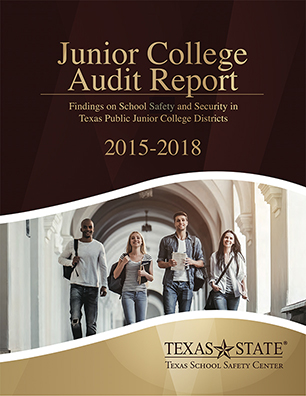TxSSC
2015-2018 Junior College Audit Report (JCAR)
Findings on School Safety and Security in Texas Public Junior College Districts

The purpose of the Junior College Audit Report (JCAR) is to provide key results of the safety and security audits completed by Texas public junior college districts (herein referred to as junior college districts). In accordance with procedures developed by the Texas School Safety Center (TxSSC) or an equivalent public or private entity, the Texas Education Code requires junior college districts to complete safety and security audits of their facilities once every three years (§37.108 (4)(b)). Audits are conducted with the aim of identifying hazards, threats, and vulnerabilities that might pose a danger to life or property and/or may interfere with a safe, secure, and healthy environment that is conducive to higher education, followed by a corrective action plan.
The TxSSC developed a model safety and security audit toolkit for junior college districts that provides guidelines showing proper audit procedures (§37.207 (1)). The audit toolkit for the 2015-2018 audit cycle included step-by-step instructions and recommendations for conducting audits, including a comprehensive audit checklist. The TxSSC captured key results of the safety and security audits completed by all Texas junior college districts. The data submitted by each junior college district were then aggregated into a statewide report for the public and the Texas State Legislature (§37.108 (4)(b)(c); (§37.207 (a)(3)).
“The purpose of the Junior College Audit Report (JCAR) is to provide key results of the safety and security audits completed by Texas public junior college districts”
Methodology
The JCAR provides a summary of safety and security information for the reporting cycle September 1, 2015 through August 31, 2018. The report is comprised of self-reported data submitted by Texas public junior college districts. The TxSSC is authorized by the Texas Legislature to determine the method used to collect the audit results, as well as the type of data necessary for collection. Data were collected via the JCARtool, an online reporting application developed by the TxSSC.

The JCARtool contained four sections and approximately 32 questions, some with multiple parts, regarding legislatively mandated safety and security audit procedures and practices. The first section of the questionnaire included demographic items and college district cumulative enrollment. The second section of the questionnaire included items related to the safety and security audit. The third section included items on the development and implementation of an emergency management program. The last section included additional safety and security information to provide contextual information about the junior college districts. The TxSSC did not substantiate the data reported by junior college districts, and the accuracy of responses received from each district was presumed.
The JCARtool was made available to districts to begin reporting audit results on April 4, 2018. Correspondence with junior college district designees included eight emails and several sets of phone calls until the JCARtool was closed on September 15, 2018. All 50 junior college districts (n = 50) reported audit results via the JCARtool, for a 100% response rate.
Major Findings
- All 50 junior college districts (100%) reported completing a safety and security audit for all campuses in their college districts.
- Fifteen junior college districts (30%) stated they had reported the results of their safety and security audits to their Board of Trustees at the time of submission to the TxSSC, whereas the remaining 35 college districts (70%) stated their audit results are scheduled to be reported at an upcoming meeting.
- Forty-four junior college districts (88%) reported their safety and security audits were conducted using audit procedures developed by the TxSSC
- All 50 junior college districts (100%) reported that they had adopted a multi-hazard emergency operations plan (EOP) and they reviewed their plan at least annually. Additionally, all 50 junior college districts (100%) reported that their multi-hazard EOP addressed each of the four phases of a comprehensive plan: 1) mitigation/prevention, 2) preparedness, 3) response, and 4) recovery.
- Forty-three junior college districts (86%) reported their multi-hazard EOP required them to conduct evacuation drills at least once each year.
- Forty-five junior college districts (90%) reported they conducted after-action reviews following each drill and actual emergencies.
- Thirty-six junior college districts (72%) reported they had conducted a THIRA or similar assessment.
- All 50 junior college districts (100%) reported they had identified key personnel responsible for emergency management. Forty-six junior college districts (92%) reported their key personnel had been trained in the NIMS and ICS.
- Forty-seven junior college districts (94%) reported they provided emergency response training to their staff and 45 junior college districts (90%) reported they provided such trainings to their administrators and faculty.
- All 50 junior college districts (100%) reported they had designated an individual responsible for monitoring compliance with the Clery Act and reported having completed an annual security report as required by the Clery Act for each year in this audit cycle.
- Forty-six junior college districts (92%) reported they had a behavioral threat assessment process to identify and work with students exhibiting threatening behaviors.
- Forty junior college districts (80%) reported they had used resources (e.g., in-person training, conferences, online tools, videos, and/or publications) developed by the TxSSC to support safety and security programs, plans, or practices.
Recommendations
Based on the findings from the 2015-2018 audit cycle, the TxSSC identified 4 key areas to serve as recommendations for improvement toward the safety and security of junior college districts in Texas. These recommendations serve to assist junior college districts to prevent/mitigate, prepare for, respond to, and recover from potential hazards, and will aid in the overarching goals of safety and emergency management—saving lives and protecting property.
- Use REMS and TxSSC resources for developing EOPs.
- Adhere to SRP CC guidance for emergency response preparation.
- Use FEMA’s THIRA guidance to identify and minimize threats.
- Employ a behavioral threat assessment process to identify threats.
Refer to the full Recommendations section on page 27 for details and resources pertaining to each recommendation.